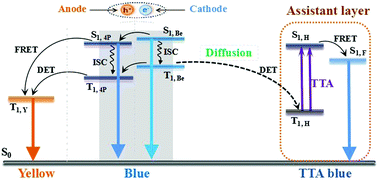Novel strategy to improve the efficiency roll-off at high luminance and operational lifetime of hybrid white OLEDs via employing an assistant layer with triplet–triplet annihilation up-conversion characteristics†
Abstract
The efficiency roll-off at high luminance and operational lifetime remain a major challenge for the widespread application of white organic light-emitting diode (WOLED) technology. Here we present a novel strategy to improve the efficiency roll-off at high luminance and operational lifetime by employing an assistant layer with triplet–triplet annihilation (TTA) up-conversion characteristics in emitters. It can be seen that at high luminance, the partial triplet energies in emitters will transfer to the TTA assistant layer and finally lead to the TTA emission, which reduces the exciton quenching at high luminance. Therefore, not only the efficiency roll-off, but also the operational lifetime are greatly improved. The resulting hybrid WOLEDs exhibited the maximum forward-viewing external quantum efficiency and power efficiency of 23.6% and 68.8 lm W−1, which only dropped to 18.3% and 38.1 lm W−1 at 1000 cd m−2 and 17.1% and 25.9 lm W−1 at 5000 cd m−2, which are significantly higher than 10.5% and 17.9 lm W−1 at 5000 cd m−2 of WOLEDs without a TTA assistant layer. Furthermore, the operational half-lifetime of the resulting hybrid WOLEDs also reached 600 hours at a luminance of 1000 cd m−2, which is nearly two-fold longer than that of the reference WOLEDs.



 Please wait while we load your content...
Please wait while we load your content...